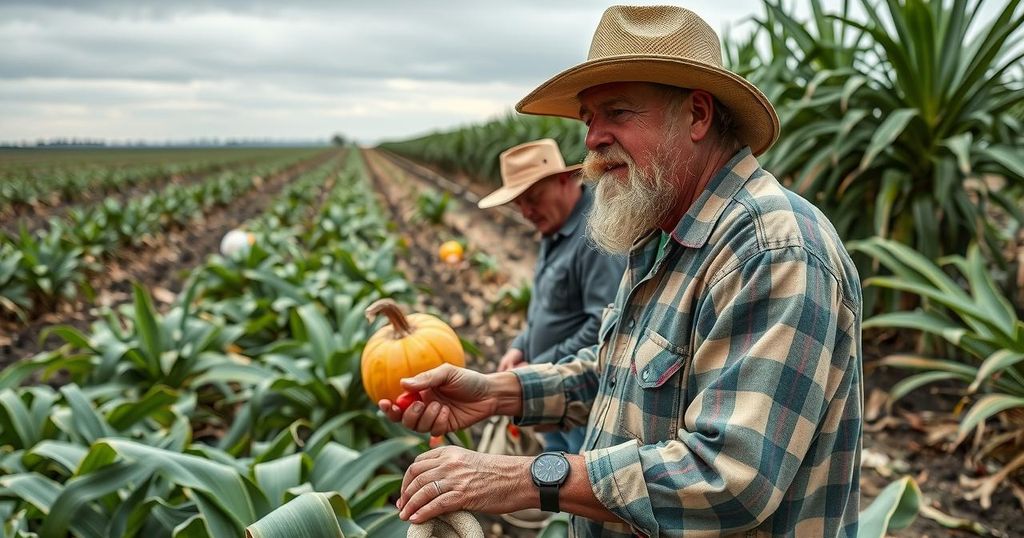Weather
World news
AFRICA, ASSOCIATED PRESS, BROOKINGS REGISTER, CHRIS HOPKINS, EUROPE/ASIA, GEORGIA, HELENE, HOPKINS, HURRICANE BERYL, NATURAL DISASTER, NATURAL DISASTERS, NORTH CAROLINA, POWER OUTAGES, SOUTH AFRICA, SOUTH CAROLINA, TOOMBS COUNTY, UNIVERSITY OF GEORGIA, VIRGINIA, WEATHER
Oliver Grayson
0 Comments
Farmers Struggle to Recover After Hurricane Helene’s Destructive Impact
Hurricane Helene’s aftermath has severely impacted Southern agriculture, with losses exceeding $10 billion. Georgia farmers have been particularly affected, facing damages that include destroyed crops and equipment. Emergency funding has been initiated, yet the long-term emotional and economic repercussions for farmers remain significant as many consider their options moving forward in recovery efforts.
Months after Hurricane Helene devastated the agricultural landscape of the South, farmers like Chris Hopkins from Georgia continue to face the aftermath. The storm, which made landfall in Florida before wreaking havoc across several states, has left lingering damage such as uprooted crops, destroyed equipment, and economic woes. Farmers estimated losses exceeding $10 billion across Florida to Virginia, with Georgia alone suffering at least $5.5 billion in damages, particularly affecting cotton growers who were in the midst of harvest. The hurricane caused irreparable harm to crops ready for picking and obliterated critical infrastructure, forcing many farmers to confront daunting decisions about their future.
Hopkins lost substantial portions of his cotton crops and, despite insurance, anticipates a staggering loss of $430,000 with additional costs for debris removal and machinery repairs. The emotional toll has made farmers question whether to rebuild or quit. The destruction extended beyond Georgia, impacting North Carolina, South Carolina, Virginia, and Florida with record flooding and storm losses.
In reaction to the disaster, Georgia’s government redirected $100 million for emergency loans, while Congress approved $21 billion in disaster aid for affected farmers across the United States. Farmers like Jeffrey Pridgen, who lost significant poultry infrastructure, face protracted recovery times, indicating a long road ahead towards normalcy. Despite the extensive damages, agricultural experts believe consumer prices may not be significantly affected, with other crop sources available. However, Georgia’s pecan production could see ramifications. The region’s agriculture is undoubtedly left to grapple with uncertainties in the wake of Hurricane Helene.
The severe impact of Hurricane Helene on agriculture was felt across the Southeastern United States in late September. Initiating as a major Category 4 hurricane, Helene left a trail of destruction affecting thousands of farms and agribusinesses, leading to extensive financial losses. Expert analyses have highlighted the vulnerability of crops and livestock during such natural disasters, particularly during peak harvesting periods. The intricate reliance of local economies on agricultural productivity emphasizes the long-term consequences resulting from the storm’s devastation. Resilience initiatives and emergency funding have become crucial in assisting recovery efforts as farmers navigate the challenges ahead.
In conclusion, Hurricane Helene’s aftermath continues to impose significant challenges on farmers throughout the South, particularly in Georgia. With estimated losses exceeding $10 billion across several states, many farmers must reassess their future in agriculture amidst extensive damages to crops and infrastructure. Emergency funding and disaster relief efforts have been mobilized, yet the emotional and financial strain on farmers lingers as they seek to rebuild their livelihoods. The recovery process will be lengthy, highlighting the critical need for support as farmers strive to overcome these unprecedented challenges.
Original Source: brookingsregister.com




Post Comment